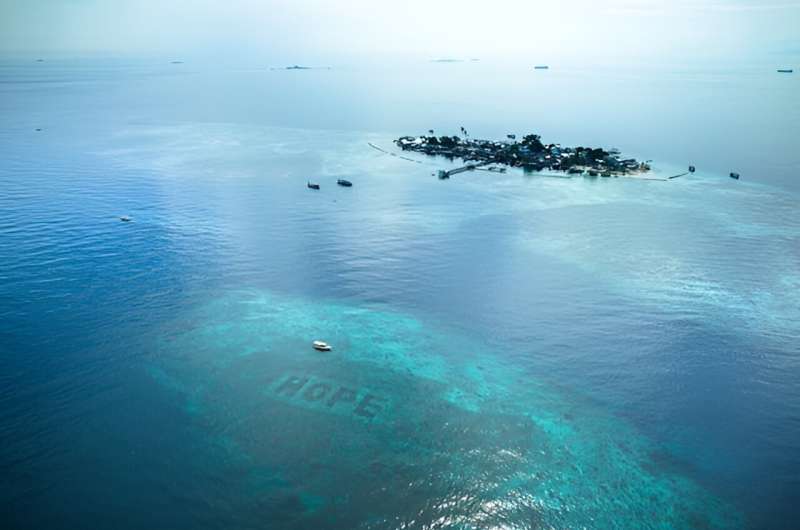This article has been reviewed according to Science X's editorial process and policies. Editors have highlighted the following attributes while ensuring the content's credibility:
fact-checked
trusted source
written by researcher(s)
proofread
Restored coral reefs can grow as fast as healthy reefs after just four years, researchers find

The coral reefs of south Sulawesi are some of the most diverse, colorful and vibrant in the world. At least, they used to be, until they were decimated by dynamite fishing in the 1990s.
As part of a team of coral reef ecologists based in Indonesia and the UK, we study the reefs around Pulau Bontosua, a small Indonesian island in south Sulawesi. Thirty years on, what were once large areas of thriving coral are now degraded sites are still devoid of color, fish and other marine life. Broken skeletons of dead corals roll around on the seabed, crushing and killing any new coral larvae that try to settle and preventing the reefs from recovering naturally.
In many places around the world, damage like this might be described as irreparable. But at Pulau Bontosua, the story is different. Here, efforts by the Mars coral restoration program have brought back the coral and important ecosystem functions, as outlined by our new study, published in Current Biology. We found that within just four years, restored reefs grow at the same rate as nearby healthy reefs.
The Mars coral restoration program is one of the world's largest restoration projects and has collaborated with local communities for more than a decade. Healthy coral fragments are attached to hexagonal, sand-covered steel frames called "reef stars". These reef stars are installed on damaged reefs, where they stabilize the loose rubble, support growth of new coral and provide habitat for reef animals to move in.
Speedy recovery
The transplanted corals grow remarkably quickly. Within a year, fragments have developed into proper colonies. After two years, they interlock branches with their neighbors. After just four years, they completely overgrow the reef star structures and restoration sites are barely distinguishable from nearby healthy reefs.
The combined growth of many corals generates a complex limestone (calcium carbonate) framework. This provides a habitat for marine life and protects nearby shorelines from storm damage by absorbing up to 97% of coastal wave energy.
We measured the overall growth of the reef framework by calculating its carbonate budget. That's the balance between limestone production (by calcifying corals and coralline algae) and erosion (by grazing sea urchins and fishes, for example). A healthy reef produces up to 20kg of reef structure per square meter per year, while a degraded reef is shrinking rather than growing as erosion exceeds limestone production. Therefore, overall reef growth gives an indication of reef health.
At Pulau Bontosua, our survey data shows that in the years following restoration, coral cover, coral colony sizes, and carbonate production rates tripled. Within four years, restored reefs were growing at the same speed as healthy reefs, and thereby provided the same important ecosystem functions.
This success is encouraging, but challenges still remain. The corals used to construct these restored reefs are predominantly branching coral types chosen by the restoration team because they are easier to attach to the reef stars. This means that restored reefs have a lower diversity of coral types than healthy reefs, which host an abundance of boulder-like and encrusting corals as well as branching types.
These structural differences may affect the species of marine life that inhabit the reef. Branching corals are also notoriously sensitive to bleaching, which happens when warmer water temperatures cause stress to corals and turn them white. Differences in the types of coral making up the reef ecosystem may, therefore, affect the reef's ability to survive future heat waves.
A warming world
Marine heat waves are becoming more frequent and severe and pose a huge threat to coral reefs and restoration efforts worldwide. Recently, thousands of nursery corals had to be rescued when water temperatures spiked in the Florida Keys.
It's imperative that coral reef restoration strategies include plans for warming waters. In some cases, efforts can be prioritized in areas where transplanted corals are less likely to encounter lethal conditions in the near future. In other cases, projects can enhance coral heat tolerance through assisted evolution.
There is some evidence that coral heat tolerance can also increase naturally. Whether this coral adaptation can keep pace with ocean warming will depend on global action to cut carbon emissions.
Outcomes of any reef restoration project will depend on environmental conditions, natural coral larvae supply, restoration techniques and the effort invested in maintaining the project. This Indonesian project shows that when conditions are right and efforts are well placed, success is possible. Hopefully, this inspires further global efforts to restore functioning coral reefs and to recreate a climate in which they can thrive.
Provided by The Conversation
This article is republished from The Conversation under a Creative Commons license. Read the original article.![]()




















